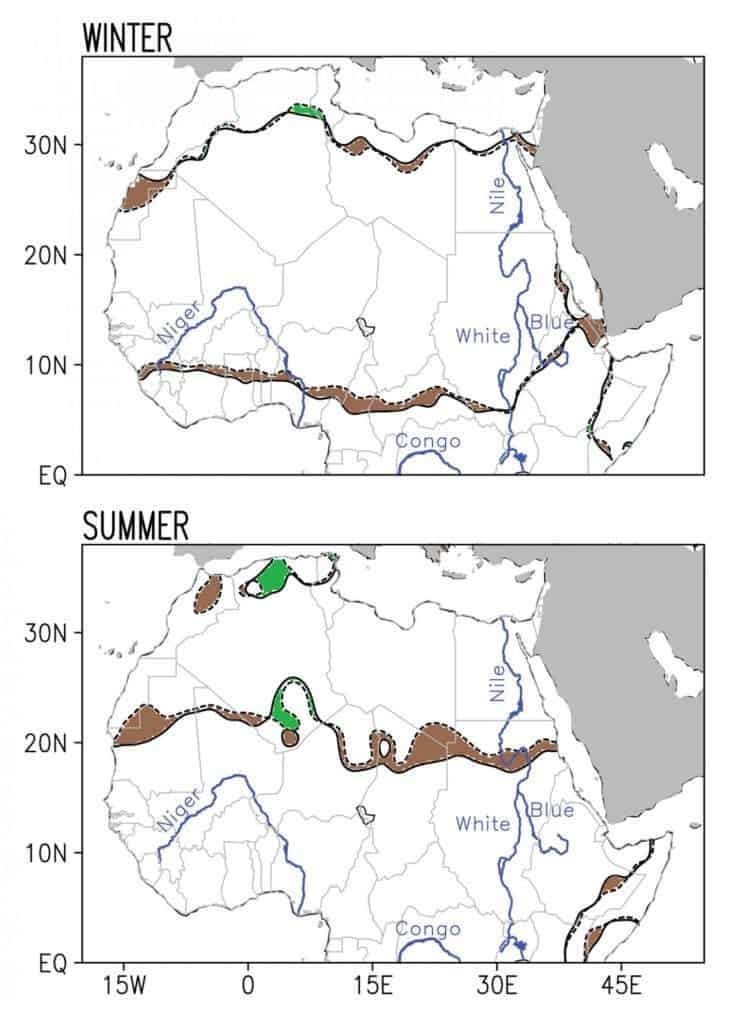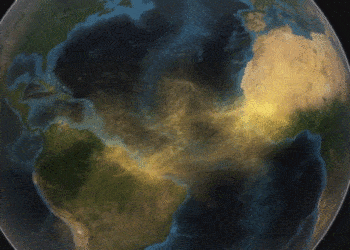
In almost a hundred years, the Sahara Desert has expanded by 10%, according to a new study. The authors say that both natural climate cycles and human-induced climate change have contributed to this worrisome expansion threatening the livelihoods of agricultural-based communities.
A continent turning to sand and dust
The Sahara is the largest hot desert in the world, and the third largest desert after Antarctica and the Arctic. Scientists typically classify a region as a desert if it receives less than 100 millimeters (4 in.) of rainfall annually.
This is not the first study to report an expansion of the Sahara, and therefore the report in and of itself is not that surprising. However, the new research carried out at the University of Maryland is unique because it analyzed trends to infer changes in the desert expanse on the century timescale.
The researchers learned by studying the rainfall data recorded throughout Africa from 1920 to 2013 that the Sahara, which occupies much of North Africa, expanded by 10%. You might not notice it by looking at a Mercator world map (notorious for its distortions), but the Sahara is actually as large as the contiguous United States.
“Our results are specific to the Sahara, but they likely have implications for the world’s other deserts,” said Sumant Nigam, a professor of atmospheric and oceanic science at UMD and the senior author of the study.
According to Nigam and colleagues, the Atlantic Multidecadal Oscillation (AMO) is one of the primary drivers of the Sahara’s rapid expansion. This is a climate cycle that affects the sea surface temperature (SST) of the North Atlantic Ocean with an estimated period of 60-80 years. There is also seasonal variability: the desert expands in the dry winter and contracts during the wetter summer, with the most notable differences occurring along the northern and southern boundaries of the Sahara.
Between the barren Sahara and the fertile savannas further south lies a semi-arid transition region called the Sahel. When the Sahara expands, the Sahel inevitably contracts, with serious repercussions for its largely agrarian human society and local grassland ecosystems.
Warm phases of the AMO are linked to increased rainfall in the Sahel, while the opposite is true during the cold phase. We’ve seen the effects of such a cold phase first hand when the Sahel dramatically dried up from the 1950s well into the 1980s. According to the researchers, another natural cycle called the Pacific Decadal Oscillation (PDO), which is characterized by temperature fluctuations in the northern Pacific Ocean on a scale of 40 to 60 years, also played a major role in the desert’s expansion.
“Deserts generally form in the subtropics because of the Hadley circulation, through which air rises at the equator and descends in the subtropics,” Nigam said. “Climate change is likely to widen the Hadley circulation, causing northward advance of the subtropical deserts. The southward creep of the Sahara, however, suggests that additional mechanisms are at work as well, including climate cycles such as the AMO.”
Lake Chad, which sits in the center of this climatologically conflicted transition zone, serves as a bellwether for changing conditions in the Sahel.
“The Chad Basin falls in the region where the Sahara has crept southward. And the lake is drying out,” Nigam explained. “It’s a very visible footprint of reduced rainfall not just locally, but across the whole region. It’s an integrator of declining water arrivals in the expansive Chad Basin.”
Besides AMO and PDO, human-induced climate change also impacted rainfall variability during the last century. The two natural cycles accounted for about two-thirds of the desert’s total expansion. The remaining third can be attributed to climate change, although the researchers caution that longer climate records which extend over numerous climate cycles would helpful in reaching a more definite conclusion.

Obviously, an expanding Sahara — which was already huge, to begin with — means very worrisome news. As Nigam mentioned earlier, other deserts around the world are likely expanding as well. Over 45,000 square miles of arable land are lost to desertification each year, by one estimate — that’s while the world’s population continues to grow, driving food demand up. The United Nations warns that desertification could drive up to 50 million people from their homes, unless humanity cuts back on greenhouse gas emissions.
“The trends in Africa of hot summers getting hotter and rainy seasons drying out are linked with factors that include increasing greenhouse gases and aerosols in the atmosphere,” said Ming Cai, a program director in the National Science Foundation’s Division of Atmospheric and Geospace Sciences, which funded the research. “These trends also have a devastating effect on the lives of African people, who depend on agriculture-based economies.”
In the future, the researchers plan on learning more about what drives desert expansion not only in the Sahara, but in other deserts around the world as well.
“With this study, our priority was to document the long-term trends in rainfall and temperature in the Sahara. Our next step will be to look at what is driving these trends, for the Sahara and elsewhere,” said Natalie Thomas, a graduate student in atmospheric and oceanic science at UMD and lead author of the research paper. “We have already started looking at seasonal temperature trends over North America, for example. Here, winters are getting warmer but summers are about the same. In Africa, it’s the opposite–winters are holding steady but summers are getting warmer. So the stresses in Africa are already more severe.”
Scientific reference: “20th-Century Climate Change over Africa: Seasonal Hydroclimate Trends and Sahara Desert Expansion,” Natalie Thomas and Sumant Nigam, was published online March 29, 2018, in the Journal of Climate.






